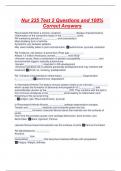Nur 235 Test 2 Questions and 100%
Correct Answers
Rheumatoid Arthritis/Is a chronic, systemic, __________ disease characterized by
inflammation of the connective tissue in the ___________ joints.
RA marked by periods of ___________ and exacerbation.
Most disabling form of arthritis.
Symptoms vary between patients.
May need mobility aides or joint reconstruction. ✅autoimmune, synovial, remission
RA Incidence, risk factors, & prevention:/Peak age __________.
Affects 1.5 million Americans; women_________ more likely
Unknown cause; likely a combination of genetic susceptibility, ____________, and
environmental triggers--typically autoimmune.
Genetic _____________--important in RA development
Smoking increases risk in patients genetically predisposed and may interfere with
treatment ✅30-50, 3x, smoking, predisposition
RA: 3 Distinct Characteristics/ Inflammation, ______________, Degeneration
(____________) ✅autoimmune ,degradation
In rheumatoid Arthritis The body's immune system reacts to an unknown ___________
which causes the formation of abnormal immunoglobulin G (___________) and
autoantibodies (known as the ________________ (RF) They combine with the IgG to
form immune complexes in the ___________ joints leading to inflammation and
thickening of the synovial lining.
. ✅antigen, IgG, Rheumatoid factor, synovial
In Rheumatoid Arthritis Muscle ___________ undergo degenerative changes.
Tendon and __________ elasticity and contractile power are lost.
_____________formation (vascular fibrous tissue that extends over the surfaces of
joints).
Over time this process causes: joint cartilage destruction, bone erosion, and
deformities. ✅fibers, ligament, Pannus
vascular fibrous tissue that extends over the surfaces of joints ✅Pannus Formation
RA Manifestations/ __________
Anorexia
___________ loss
Generalized ___________ that becomes localized stiffness with progression
✅Fatigue, Weight, stiffness
,RA Manifestations: Joints/ Pattern of joint involvement typically begins in the
____________ joints of the hands, wrist and feet.
Knees, hips, elbows, ankles, cervical spine and ___________ joints may also be
affected. ✅small, temporomandibular
RA Manifestations in the joints may start with _____________stiffness-________
minutes to several hours.
Pain
Limited motion
Signs of ____________ (erythema, heat, swelling, tenderness) ✅Morning, 60,
inflammation
RA Manifestations in the joints __________
____________
Deformities in the hands ✅Tenosynovitis, Subluxation
term that is used when a joint doesn't work the way it's supposed to, whether it's simply
not moving how it should or it's misaligned leads to numbness, tingling, pain, and
burning in that area of the body. ✅subluxation
inflammation of the lining of the sheath that surrounds a tendon (the cord that joins
muscle to bone) ✅tenosynovitis
Other RA Manifestations: Extra-articular (outside a joint) Flexion contractures,
Depression, ___________ syndrome, __________ Syndrome ✅Sjogren's, Felty
is a disorder of your immune system identified by its two most common symptoms —
dry eyes and a dry mouth. The condition often accompanies other immune system
disorders, such as rheumatoid arthritis and lupus. ✅Sjogren's syndrome
disorder that includes rheumatoid arthritis, a swollen spleen, decreased white blood cell
count, and repeated infections. It is rare. ✅Felty Syndrome
Stages of Rheumatoid Arthritis Stage 1/ ___________
X-ray: soft tissue ________, possible ___________, no joint ___________ ✅Synovitis,
swelling, osteoporosis, destruction
Stages of Rheumatoid Arthritis Stage 2/ Increased joint __________
Gradual destruction in joint ____________
_____________ joint space from loss of cartilage ✅inflammation, cartilage, Narrowing
Stages of Rheumatoid Arthritis Stage 3/ Formation of synovial _____________(extra
growth in joints; painful)
, X-ray: extensive cartilage _____________,___________ at joint margins, possible
____________ ✅pannus , loss, erosion, deformity
Stages of Rheumatoid Arthritis Stage 4/ Inflammatory process ___________
Loss of joint ___________
Formation of subcutaneous ____________ ✅subsides, function, nodules
RA: Diagnostic Studies History and physical findings; duration of symptoms
Criteria for diagnosis ___________ involvement
Lab findings:
____________positive in ______________ pts.
__________and __________ are increased as general markers of active inflammation.
Anti-CCP (antibodies to citrullinated peptide) present in _________ pts and can be seen
__________ years before symptoms develop.
___________ (antinuclear antibody)-increased in autoimmune reaction
___________ fluid analysis- cloudy, straw-colored fluid with many fibrin flecks.
Bone scan to detect early joint changes.
X-rays to monitor disease progression and treatment effectiveness. ✅Joint, RF , 70-
90%, ESR , CRP, 60-80%, 5-10, ANA, Synovial
RA Treatment: Goals at all phases of RA Must begin _______to avoid deformity
Decrease joint ________ and swelling
Achieve clinical _____________
Decrease likelihood of joint deformity
Minimize disability/Maximize participation in ADLs ✅early , pain, remission
RA: Management (interdisciplinary) _____________ therapy
Non-pharmacologic therapy
____________ and activity
____________promotion
The progression of joint damage can be slowed or stopped with aggressive, early
treatment. ✅Pharmacologic, Exercise, Sleep
RA Treatment Disease-modifying ____________ drugs (DMARDs ) Slow disease
progression and decrease risk of joint _______________ and erosion
Drug chosen based on disease__________________, functional level, and lifestyle
considerations ✅antirheumatic, deformity, activity
RA Drug Therapy: DMARDs _____________
___________ treatment
Lower __________ ✅Methotrexate , Early, toxicity
Methotrexate Side effects (rare): _________ marrow suppression and hepatotoxicity
Need to monitor CBC and blood chemistry




